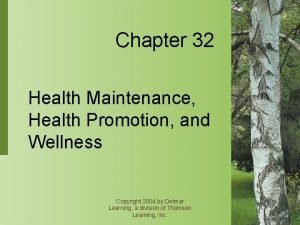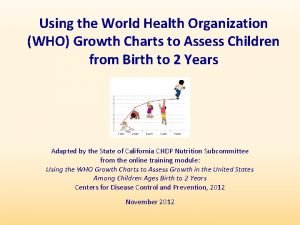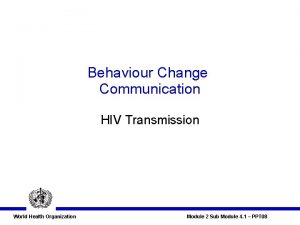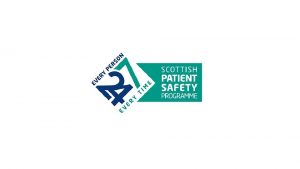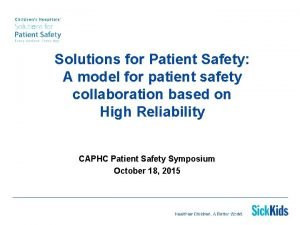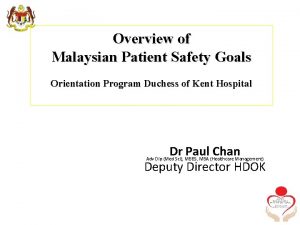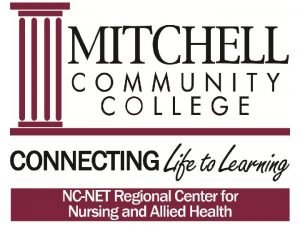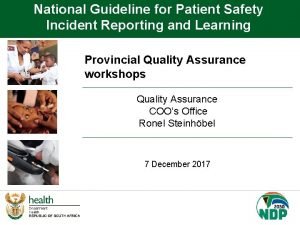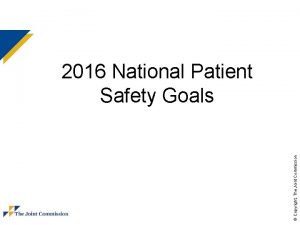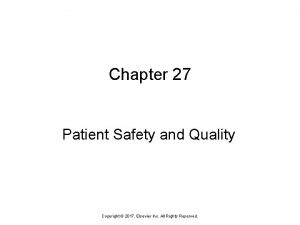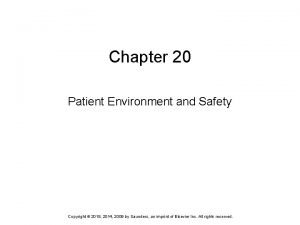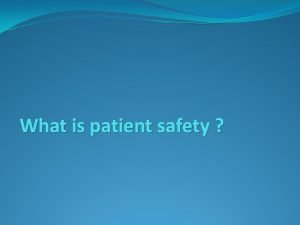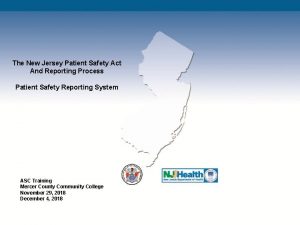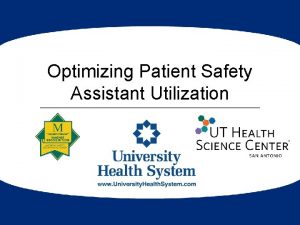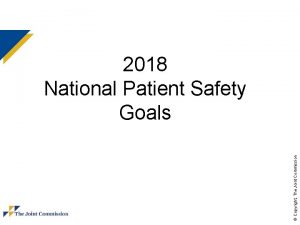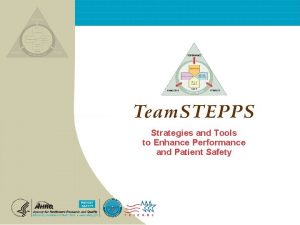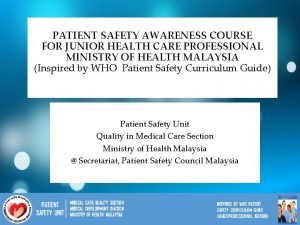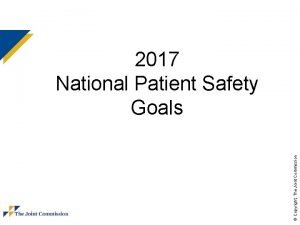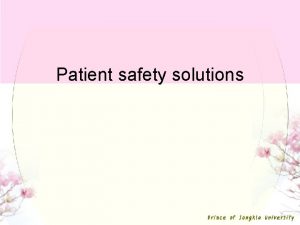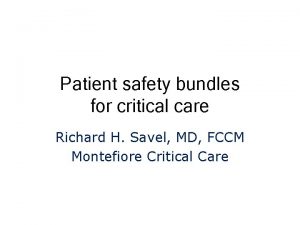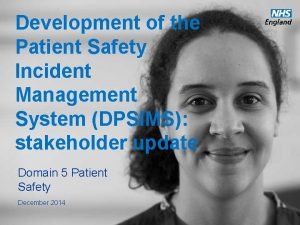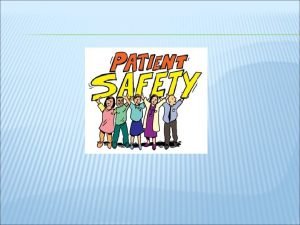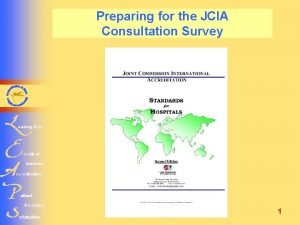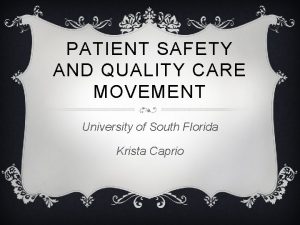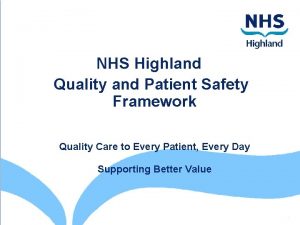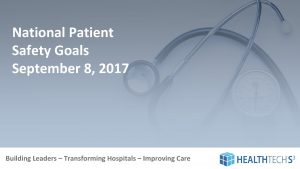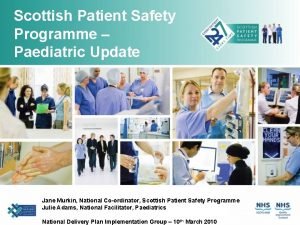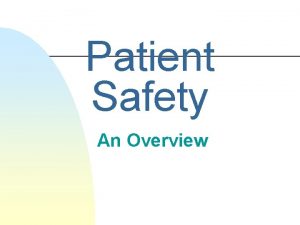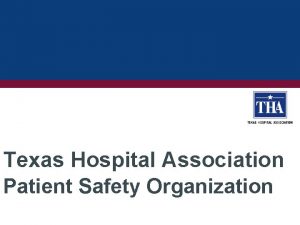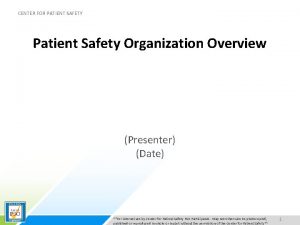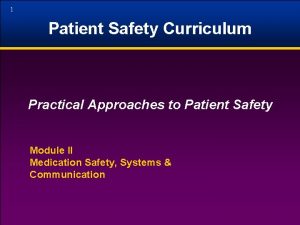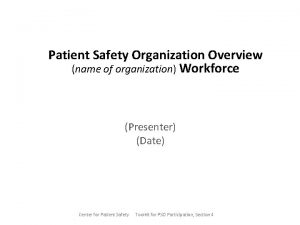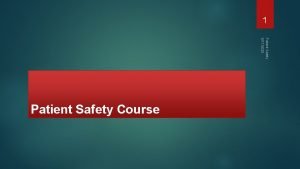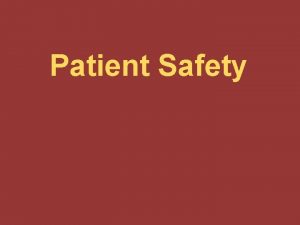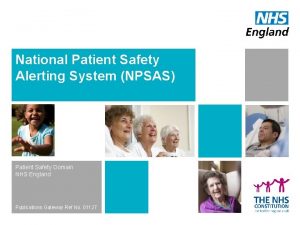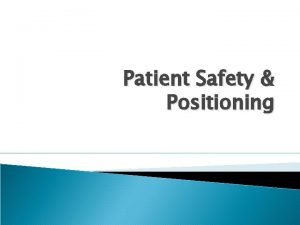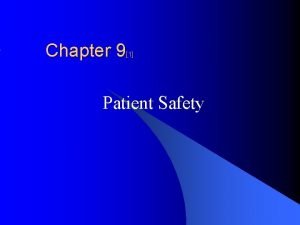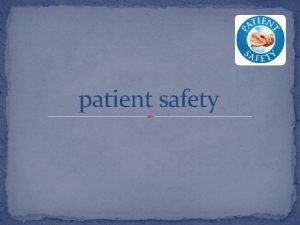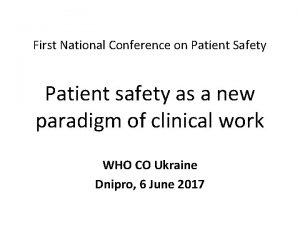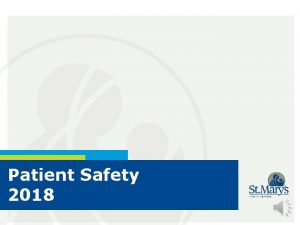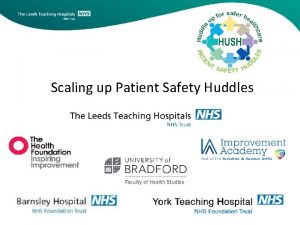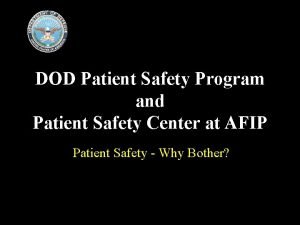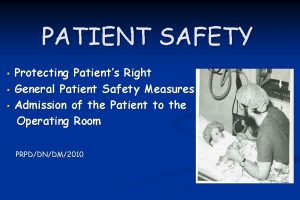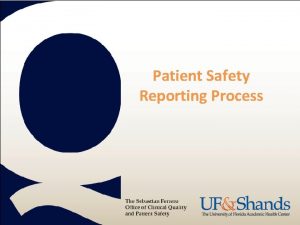WORLD HEALTH ORGANIZATION PATIENT SAFETY CURRICULUM GUIDE MULTIPROFESSIONAL































- Slides: 31

WORLD HEALTH ORGANIZATION PATIENT SAFETY CURRICULUM GUIDE MULTI-PROFESSIONAL EDITION

Contents: 1. Processes of WHO Curriculum Guide 2. Why Patient Safety Education? What is the Curriculum? How to use it? 3. Principles and structure 4. Medical school curriculum, evaluation 5. Multi-professional curriculum

PATIENT SAFETY PROBLEM “Human beings make mistakes because the systems, tasks and processes they work in are poorly designed. ” Dr Lucian Leape, testifying to the US President’s Commission on Consumer Protection and Quality in Health

PATIENT SAFETY AND EDUCATION 'Patient safety is a core attitude and thus needs to be introduced early and then reinforced throughout postgraduate education and continuing professional development. ' Stefan Lindgren, President of the World Federation for Medical Education

WHO PATIENT SAFETY AND EDUCATION 2008: Patient Safety Education programme initiated 2009: Launch of the Patient Safety Curriculum Guide for Medical Schools 2010 Evaluation of Curriculum Guide for Medical School in 12 pilot sites (9 countries) 2010: Patient Safety Curriculum Guide: Multi-professional edition initiated 2010: Regional experts and intl. foundations engaged 2011: Completion of multi-professional edition (Spring) 2011: Launch of the Patient Safety Curriculum Guide: Multi-professional edition around the world 2011: Development of tools for introducing the curriculum in universities 2011 - Development of courses/ e-courses based on patient safety curriculum guide


l tm x. h / de n i / en rr /cu i o. pa / t n i : //w p t t h w. w ti sa ent fe ion t a uc d e ty/ um cul

WHY PATIENT SAFETY EDUCATION ? § Modern healthcare comes with huge benefits but also many risks § Because of risks to patient safety, all health care providers, managers, organizations, governments must become familiar with quality and patient safety § Patient safety education and training is limited § Students must be trained to practice safe care, manage challenges § Patient safety education is not stand alone: it integrates in all health care topics and education § Teaching patient safety skills should begin in 1 st year students

The Problem Systemic problems • Mismatch of competencies to patient & population needs • Poor teamwork • Gender stratification of professional status • Narrow technical focus without broader contextual understanding • Episodic encounters • Hospital orientation • Weak leadership in health system performance Professional education not kept pace Today more complex, costly health care Integrated modern science into curricula at university based schools

WHY WAS THE CURRICULUM DEVELOPED? § Patient safety education not kept up with workforce requirements § Several factors impede patient safety education: 1. lack of recognition by educators that teaching patient safety is essential and skill can be taught 2. educators not familiar with literature /how to integrate patient safety into existing curricula 3. reluctance to address knowledge that originates from outside one's profession (systems thinking and quality improvement, patient safety methodologies) 4. attitudes of traditional teacher–student hierarchical § Curriculum fills gap by: supporting educators to build foundation knowledge and skills for all health care students and prepare them for practice

WHAT IS THE CURRICULUM GUIDE ? Part A: Teachers Guide to assist teachers implement curriculum guide and building capacity in patient safety education Comprehensive programme for educating in patient safety Part B: Comprehensive, ready to teach, topicbased patient safety programme that can be implemented as a whole or per each topic ( or module)

HOW TO USE THE CURRICULUM GUIDE Introduce all curriculum topics/modules OR one topic at a time. Each topic contains technical information and instructions on how to teach it. Universities and faculties Suggestions about introducing case studies are provided The topics have been designed so that students can be responsible for much of their own learning (e. g reading on line materials) Educators encouraged to add professional literature and data on topics to teach.

PATIENT-CENTRED CARE REQUIRES: New knowledge & skills required Partnerships with patients & carers Teamwork Risk management/communication Data collection Adverse events Professional responsibility Professional accountability Competent care providers Deliver patient centred care Active member of multidisciplinary teams Report and learn from errors Apply evidenced-based health care Ethical and safer practices Use quality improvement and patient safety approaches Use information technology

AIMS: PATIENT SAFETY CURRICULUM GUIDE Prepare students for safer practices in workplace Inform universities/ faculties in patient safety topics Provide comprehensive curriculum to assist teaching, integrating patient safety learning Develop capacity for patient safety educators Strengthen patient safety education in universities/faculties Raise international profile of patient safety and foster international collaborations on patient safety education, researc

WHO PATIENT SAFETY CURRICULUM GUIDE Based on multi professional Australian Patient Safety Education Framework § Evidenced based § Identify learning outcomes § Build on what is currently taught § Identify how patient safety could be integrated into current programmes

WHO PATIENT SAFETY CURRICULUM GUIDE Underpinning principles: § Capacity-building is integral to curriculum change § A flexible curriculum § Easily understood language § A guide for all countries, cultures and contexts § A guide based on learning in a safe and supportive environment

WHAT IS THE CURRICULUM GUIDE ? Designed to build capacity and program planning and design Part A: Teachers Guide to assist teachers implement curriculum guide and building capacity in patient safety education Comprehensive programme for educating in patient safety One stop shop: * Flexible * Educators can start it at any stage * Can apply entire curriculum or Part B: topics selective Comprehensive, on case by basis ready to case teach, topic- based patient safety programme that can be implemented as a whole or per each topic ( or module)

PART A: TEACHERS GUIDE § Designed for faculty staff and clinician teachers § Provides a step by step tutorial § Easily adaptable for other health professionals § Designed to assist, facilitate and guide faculty in their approach to patient safety education

CONTENT OF PART A: TEACHERS GUIDE § How were topics selected § Implementing the guide § How to evaluate patient safety curriculum § How to integrate patient safety into your curriculum § Web based tools and resources § Educational principles essential for patient safety teaching & learning § Activities to assist patient safety understanding § How to assess for knowledge of patient safety (students' testing) § How to foster & engage in a transnational approach to patient safety

WHO PATIENT SAFETY CURRICULUM GUIDE: CULTURE CHANGE AREA or ATTRIBUTE EXAMPLES OLD WAY NEW WAY Medical Hierarchies Hand hygiene: Doctor does not clean hands between patients Student says nothing and conforms to inadequate practices. Imitates senior doctor. (1) Seek clarification on the 'when and how' for hand hygiene with the doctor or other senior person. (2) Say nothing but use safe hand hygiene practices (3) Say something in respectful manner to the doctor concerned and continue to use safe hand hygiene practices Medical Hierarchies Site of surgery Surgeon does not participate in checking the correct site for surgery or verifying the correct patient The surgeon is resentful of the pre-operative checking protocol, believing it to be a waste of time, and pressures the rest of the team to hurry-up. Adopt the approach of the surgeon and don’t participate in checking – decide that checking is too menial a task for a doctor anyway. (1) Actively help the rest of the team to complete the checking protocol

PART B: TOPICS OF THE CURRICULUM 1. What is patient safety? 2. What is human factors engineering? 3. Understanding systems and the impact of complexity on patient care 4. Being an effective team player 5. Understanding and learning from errors 6. How to manage clinical risk 7. Methods for quality improvement 8. Engaging with patients and carers 9. Minimising infection through improved Infection control 10. Reducing risks associated with Invasive procedures 11. Improving medication safety

PART B: STRUCTURE OF EACH TOPIC § Topic title § Rationale § Learning outcomes - Knowledge requirements - Performance requirements § How to teach this topic - Strategies & activities - Tools & resources § How to assess this topic § How to evaluate the teaching session

WHO PATIENT SAFETY CURRICULUM GUIDE FOR MEDICAL SCHOOLS: EVALUATION § Nine countries ( 1 2 sites) worldwide Argentina, USA, UK (Scotland), Israel, Saudi Arabia, Nepal, India, Australia, Ethiopia § Study led by University of Aberdeen, ended 2010 § Mixture of techniques ( quantitative and qualitative) § What is the impact of the teaching on students? § How usable is the WHO Patient Safety Guide? § Can this curriculum be used for widespread implementation of patient safety education globally? Evaluation of Patient Safety Curriculum Guide for Medical Schools undertaken by University of Aberdeen

WHO PATIENT SAFETY CURRICULUM GUIDE FOR MEDICAL SCHOOLS: MAIN EVAL. OUTCOMES § WHO Curriculum Guide is highly valued with clear structures and excellent content § Recommendations to educators are particularly useful § Most schools received unsolicited remarks from students on how positive was to include patient safety. (Students reported medium to nil levels knowledge of patient safety and med errors before initiations of teaching) § General agreement on all schools that teaching has been positively received § All schools included a minimum of 3 topics and 2 schools all 11 topics: Most taught topics: What is patient safety? Infection control, 2 schools took : 'Human factors' topic § All schools will continue to teach topics introduced, 5 schools plan for introduction of new topics and 3 more to include all 11 topics; Some schools plan introduction of new educators to teach patient safety

WHO PATIENT SAFETY CURRICULUM GUIDE: MULTIPROFESSIONAL EDITION § First wave focus on medical schools § Widespread demand for broader second edition § Recognition of common underlying principles § Balance need for profession-specific material § Inter-professional vs. segregated learning

WHO PATIENT SAFETY CURRICULUM GUIDE: MULTIPROFESSIONAL EDITION Working with international professional federations ■ World Dental Federation ■ International Confederation of Midwives ■ International Council of Nurses (including EFN) ■ International Pharmaceutical Federation Working with student bodies ■ International Association of Dental Students ■ International Pharmaceutical Students Federation ■ International Council of Nurses Student Network ■ International Federation of Medical Students Associations

Patient Safety Curriculum Guide: Expert Working Group Members Regional Experts Professor E. Acosta-Gio (OSAP and ADM): School of Dentistry, National University of Mexico (UNAM), Mexico, D. F. , Mexico Multi-Professional Experts Professor M. Airaksinen (FIP): Faculty of Pharmacy, University of Helsinki, Finland Professor A. Crisostomo (West Pacific Region): Department of Surgery, UPCM-PGH, Manila, Philippine Professor M. Barger (ICM): Department of Family Health Care Nursing, University of California, San Francisco, USA Mr M. A. Hamandi (Eastern Mediterranean Region): Makassed General Hospital, Beirut, Lebanon Professor J. Barry (ICN): Nursing and Health Policy, International Council of Nurses, Geneva, Switzerland Ms T. Nauiseb (African Region): Faculty of Health & Medical Sciences, University of Namibia, Windhoek, Namibia Ms R. Sitompul (South East Asian Region): School of Nursing, Universitas Pelita Harapan (UPH), Jakarta, Indonesia Professor J. Vlček (European Region): Department of Social and Clinical Pharmacy, Charles University, Heyrovskeho, Czech Republic Mr S. M. Chittoory (IPSF): Massachusetts College of Pharmacy and Health Sciences (MCPHS), Boston, USA Mrs M. Murphy (Patient Champion): Patients for Patient Safety Programme, WHO PSP, Cork, Ireland Dr J. Rohe (WMA): Agency for Quality in Medicine, Berlin, Germany Professor N. Yamalik (FDI): Department of Periodontology, Hacettepe University, Ankara, Turkey

The WHO team External Expert Lead: Prof. B. Barraclough, Clinical Lead/Chair, WHO Curriculum Working Group Lead writer: Prof. M. Walton, Sydney School of Public Health, Faculty of Medicine, University of Sydney, Australia Programme Manager: Dr A. Leotsakos, World Health Organization, Patient Safety Programme Consultant: Dr B. Ellis Programme Support: Ms C. Nakandi, Dr H. Zheng, World Health Organization, Patient Safety

Download the Curriculum and teaching slides for free: http: //www. who. int/patientsafety/education/curriculum

National Patient Safety Education Framework Walton M, Shaw T, Barnett S, Ross J Developing a National Patient Safety Education Framework for Australian Quality and Safety in Health Care 2006 15: 437 -42 What exactly is patient safety? Emanuel L, Berwick D, Conway J, Combes J, Hatlie M, Leape L, Reason J, Schyve P, Vincent C, Walton M. In: Henriksen K, Battles J B, Keyes M A, Grady ML, eds. Advances in Patient Safety: New Directions and Alternative Approaches. Rockville: Agency for Healthcare Research and Quality August 2008 WHO Patient Safety Curriculum Guide for Medical students Walton M, Woodward H, Van Staalduinen S, Lemer C, Greaves F, Noble D, Ellis B, Donaldson L, Barraclough B The World Health Organization (WHO) Patient Safety Curriculum Guide for Medical Schools ( for submission)

THANK YOU 31
 Health maintenance and promotion
Health maintenance and promotion Oie world organization for animal health
Oie world organization for animal health World health organization growth charts
World health organization growth charts World health organization
World health organization World health organization photos
World health organization photos Patient 2 patient
Patient 2 patient Scottish patient safety programme
Scottish patient safety programme Solutions for patient safety bundles
Solutions for patient safety bundles Malaysian patient safety goals
Malaysian patient safety goals National patient safety goals 2012
National patient safety goals 2012 Patient safety incident policy
Patient safety incident policy To err is human to cover up is unforgivable
To err is human to cover up is unforgivable Joint commission national patient safety goals 2016
Joint commission national patient safety goals 2016 Chapter 27 patient safety and quality
Chapter 27 patient safety and quality Chapter 20 patient environment and safety
Chapter 20 patient environment and safety Sentinel event
Sentinel event Nj patient safety act
Nj patient safety act Christine andre
Christine andre Dod patient safety program
Dod patient safety program 2018 national patient safety goals
2018 national patient safety goals Sue sheridan patient safety
Sue sheridan patient safety Patient safety goals - awareness course
Patient safety goals - awareness course National patient safety goals 2017
National patient safety goals 2017 Patient safety solutions
Patient safety solutions Ihi care bundles
Ihi care bundles Patient safety incident management system
Patient safety incident management system 2013 hospital national patient safety goals
2013 hospital national patient safety goals Patient safety goals
Patient safety goals Patient safety and quality care movement
Patient safety and quality care movement National patient safety framework
National patient safety framework Npsg 8
Npsg 8 Scottish patient safety programme
Scottish patient safety programme
